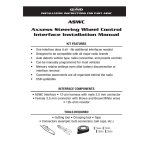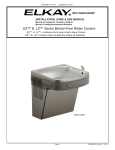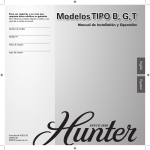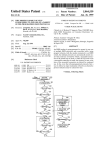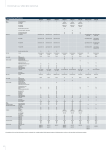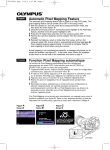Download Metra Stereo Dash Kits Installation Instructions
Transcript
INSTALLATION INSTRUCTIONS FOR PART 99-3012G APPLICATIONS Chevy Sonic 2012-up 99-3012G WIRING & ANTENNA CONNECTIONS (sold separately) Wiring Harness: • Interface included Antenna Adapter: • 40-EU55 multi-use antenna adapter KIT FEATURES • ISO DIN head unit provision with pocket • DDIN head unit provisions • Interface included retains factory OnStar, Bluetooth, steering wheel controls, and all warning chimes • Provides a 12-volt accessory power and VSS, parking brake, and reverse signals • Painted Gray to match factory finish KIT COMPONENTS • A) Radio trim panel • B) Radio brackets • C) Pocket • D) (4) #8 x 3/8” Phillips truss-head screws • E) Panel clips • F) Interface • G) 16-pin harness • H) 4-pin to 4-pin resistor pad • I) Resistor • J) 22-pin to 44-pin harness • K) Female 3.5mm connector w/ Brown and Brown/White Wires A B G C D H I E J TOOLS REQUIRED • Panel removal tool • Phillips screwdriver • Socket wrench F K CAUTION: Metra recommends disconnecting the negative battery terminal before beginning any installation. All accessories, switches, and especially air bag indicator lights must be plugged in beforereconnecting the battery or cycling the ignition. NOTE: Refer to the instructions included with the aftermarket radio. 99-3012G Dash Disassembly 1. Using a panel removal tool, unsnap and remove the panel surrounding the radio (vents above radio included). (Figure A) 2. Unclip and remove the factory A/C vents from the radio trim panel. 3. Remove four 7mm screws to remove the radio. (Figure B) Continue to kit assembly (Figure A) (Figure B) 99-3012G Kit Assembly ISO DIN head unit provision with pocket Double DIN head unit provisions 1. Install factory vents into the radio trim panel. (Figure A) 1. Install factory vents into the radio trim panel. (Figure A) 2. Install the four included panel clips onto the appropriate locations of the radio trim panel. 2. Install the four included panel clips onto the appropriate locations of the radio trim panel. 3. Mount the pocket to the radio brackets with the (4) #8 x 3/8” Phillips screws supplied. (Figure B) (Figure A) 4. Slide the head unit into radio brackets and secure with screws supplied with the radio. (Figure B) 5. Locate the factory wiring harness and antenna plug in the dash. Metra recommends using the proper mating adapters from Metra and/or AXXESS. Test the unit for operation. 6. Mount the new radio assembly into the dash, snap-in the radio panel, and reassemble dash in reverse order of disassembly. (Figure C) (Figure B) 3. Slide the Double DIN head unit into the radio housing brackets and secure with screws supplied with the unit. (Figure B) 4. Locate the factory wiring harness and antenna plug in the dash. Metra recommends using the proper mating adapters from Metra and/or AXXESS. Test the unit for operation. (Figure A) (Figure B) 5. Mount the new radio assembly into the dash, snap-in the radio panel, and reassemble dash in reverse order of disassembly. (Figure C) (Figure C) (Figure C) 99-3012G Axxess Interface Installation FEATURES • • • • • • • • • • • Provides accessory (12-volt 10-amp) Retains R.A.P. (Retained Accessory Power) Used in amplified or non-amplified systems Retains all warning chimes Provides NAV outputs (parking brake, reverse, mute, and V.S.S.) Built in ASWC (Steering Wheel Control Interface) Retains OnStar/OE Bluetooth Adjustable volume for chimes and OnStar High level speaker input Micro “B” USB updatable Retains balance and fade INTERFACE COMPONENTS • 4-pin to 4-pin resistor pad harness • 16-pin with stripped leads • 22-pin to 44-pin Camaro Harness • 18-pin to 10-pin HVAC Harness • Female 3.5mm connector with Brown and Brown/White wires • Resistor TOOLS REQUIRED • Cutting tool • Crimping tool • Tape • Connectors (butt-connectors, bell caps, etc.) Installing the Interface From the 16-pin harness: • Connect the Red wires to the ignition/accessory wire of the aftermarket radio • Connect the Orange/White wire to the illumination wire of the aftermarket radio. If the aftermarket radio has no illumination wire, tape off the Orange/White wire. • Connect the Blue/White wire to the amp turn on wire of the aftermarket radio. • Connect the Brown wire to the mute wire of the aftermarket radio. If the aftermarket radio does not have a Mute wire, tape up the Brown wire. • Connect the White wire to the left front positive speaker output of the aftermarket radio • Connect the White/Black wire to the left front negative speaker output of the aftermarket radio • Connect the Gray wire to the right front positive speaker output of the aftermarket radio • Connect the Gray/Black wire to the right front negative speaker output of the aftermarket radio • The Violet wire is not used in the application • The Violet/Black wire is not used in the application • The Green wire is not used in the application • The Green/Black wire is not used in this application. The following wires are for the aftermarket radios that have navigation built in: • Connect the Light Green wire to the parking brake wire of the aftermarket navigation radio. • Connect the Blue/Pink wire to the VSS or speed sense wire of the aftermarket navigation radio. • Connect the Green/Purple wire to the reverse wire of the aftermarket navigation radio. From the 22-way harness: • Connect the 3.5mm jack to your aftermarket radios steering wheel control input (if equipped) Note: If using an Eclipse, Kenwood, or select JVC radios, use supplied female 3.5 adaptor. For Kenwood and select JVC radios: Connect the SWC wire (normally Blue/Yellow) to the Brown wire of the ASWC. Isolate and tape the Brown/White wire, it will not be used. Some of the newer Kenwood radios will auto detect as a JVC. If this is the case, you can use a 12k ohm resistor (included) in line between the Blue/Yellow and brown wire of the female 3.5mm jack during programming only. Or you can manually set the radio type which is in the radio programming section of this manual. For Eclipse: Connect the Eclipse SWC wires (normally Axxess Interface Installation 99-3012G Installing the Interface Brown and Brown/Black) to the Brown and Brown/ White wires of the ASWC. Brown goes to Brown and Brown/White goes to Brown/Black. Sometimes this is reversed, so reverse the wires if needed. For Metra OE radios: Connect the SWC Key 1 wire (Gray) to the Brown wire of the ASWC female 3.5mm adapter. For all other radios, plug in the male 3.5mm connector of the ASWC into the back of the aftermarket radio, designated for an external SWC control interface. Please refer to the aftermarket radios manual if you are in doubt where the 3.5mm connector of the ASWC goes. The Black/Yellow wire will be discussed later on in the instructions From the 44-way harness: • Connect the Black wire to the ground wire of the aftermarket radio. • Connect the RCA’s to the AUX in on the aftermarket radio (if equipped). Note: This will allow you to retain the 3.5 AUX JACK in the console. • Connect the Yellow wire to the 12-volt constant wire of the aftermarket radio. • If the vehicle is amplified disconnect the 4-pin harness located between the 44-way and 22-way connector and connect the supplied 4-pin to 4-pin resistor pad. Amplified vehicles: • Connect the Violet wire to the right rear positive wire of the aftermarket radio • Connect the Violet/Black wire to the right rear negative wire of the aftermarket radio • Connect the Green wire to the left rear positive wire of the aftermarket radio • Connect the Green/Black wire to the left rear negative wire of the aftermarket radio Non-amplified vehicles: • Cut the resistors from the Green, Green/black, Purple, Purple/Black right below the heat shrink • Connect the Violet wire to the right rear positive wire of the aftermarket radio • Connect the Violet/Black wire to the right rear negative wire of the aftermarket radio • Connect the Green wire to the left rear positive wire of the aftermarket radio • Connect the Green/Black wire to the left rear negative wire of the aftermarket radio The Pink wire is not used in this application. Installing the Interface: 1. With all the connections completed, plug the 16 and 22 pin harnesses into the interface. 2. Plug the 44 pin GM harness into the vehicle side harness, and plug the aftermarket radio harness into the aftermarket radio. 3. Reconnect the negative battery terminal. Programming: • You must cycle the A/C fan speed all the way to high and back to low when you first install the kit. Note: Continue to the “Testing the Interface” section if you do not have factory audio controls on the steering wheel. Programming the Steering Wheel Controls 1. Turn on the ignition. 2. The SWC status LED on the interface will begin to blink rapidly. 3. Tap volume up steering wheel control until the LED stops blinking rapidly. 4. The LED will go off when it detects the car. Axxess Interface Installation 99-3012G Programming the Steering Wheel Controls 5. It will then will blink the LED the number corresponding to the radio type. 6. After a few seconds, the LED will then blink the number of times corresponding to the radio ID type. Testing the Interface With the vehicle battery re-connected, cycle the key on and off once and back on. Turn the ignition on, and then turn the aftermarket radio on. Push the OnStar button, the radio should turn off (radio will mute if mute wire is connected) and you should hear OnStar. Push the OnStar cancel button and the radio should come back on. Cycle the A/C fan speed all the way to high and back to low when you first install the kit. Chime Volume Adjustment 1) With car on, shut off car and leave keys in ignition. Open the car door and leave it open. Chimes will be heard. 2) Wait 10 seconds, then with a small screwdriver adjust the potentiometer fully counterclockwise (all the way left), then clockwise to raise chime level and counterclockwise to lower the chime level. 3) When the volume is at the desired level, remove the keys from the ignition. This will lock the chime volume at its current level. Audio Level Adjustment 1) Start your vehicle and turn on the radio having audio playing. 2) Turn your aftermarket radio’s volume up ¾ of the way. 3) With a small screwdriver adjust the potentiometer clockwise to raise the audio level and counterclockwise to lower the audio level. 4) Once at desired level your audio adjustment is complete. OnStar Level Adjustment 1. To manually program the aftermarket radio, turn on the ignition, press and hold the “Volume Down” button on the steering wheel control until the LED goes solid red, then release “Volume Down”. 2. Press the “Volume Up” the number of times needed to program the radio type. 3. Here is the chart to show how many presses of the “Volume Up” button is needed for which radio you are trying to program: 1 2 3 4 5 6 Eclipse Kenwood Clarion “Type 1” Sony/Dual JVC Pioneer/Jensen 7 8 9 10 11 Alpine Visteon Valor Clarion “Type 2” Metra OE To adjust the OnStar volume level find the Black/Yellow wire on the 16-pin harness. Push the blue OnStar button, while the voice is speaking tap the Black/Yellow wire to ground. Once the volume is set it will stay at that volume until the Black/Yellow wire is tapped to ground again. This can be set during installation and then left alone. If user adjustment is desired, the customer may also tap “Volume Up” or down on the steering wheel (if equipped) to adjust the OnStar level. 4. Press and hold the “Volume Down” button for 5 seconds to finish programming. The LED will then go off. To manually set the radio type: If the LED flashes do not match the radio you have connected, you must manually program the ASWC to tell it what radio it is connected to. 5. After a few seconds, the LED will then blink the number of times corresponding to the radio type. This number should be the same number the user has just pressed the “Volume Up” button. Axxess Interface Installation 99-3012G Remapping the SWC buttons Let’s say you have the 99-3012G programmed to your vehicle and your radio and you want to change the button assignment for the steering wheel controls. For instance you would like “Seek Up” to be “Mute”. First a few notes: • The 99-3012G must have detected the vehicle and radio it is attached to before you can remap. • You can only start the remapping of the steering wheel controls process after 20-seconds of turning the ignition key on. If you wait longer than the 30-seconds you will have to turn the ignition off then back on again. • Within the first 20-seconds if any button other then “Volume Up” or “Volume Down” is pushed, the remapping process will stop. • If during the remapping process no button is pushed for 30-seconds the remapping process is aborted and the original settings are reset. So let’s begin the remapping process: 1. Ideally having the 99-3012G visible is recommended since you can see the LED flashes to confirm button recognition. 2. Turning off the radio is recommended. 3. After 20-seconds of turning the ignition on, press and hold down the “Volume Up” button for at least 25-seconds. 4. The LED will light up solid red. Release “Volume Up” and the LED will go out. “Volume Up” has now been programmed. 5. Follow the list below in order however pushing the steering wheel control button you want for the function below. If you want to skip a command press the “Volume Up” on the steering wheel, this will tell the 99-3012G to skip the command and go to the next one. 1 2. 3. 4 5 6 7 Volume Up Volume Down Seek Up/Next Seek Down/Prev Source/”Mode” Mute Preset Up 8 9 10 11 12 13 14 Preset Down Power Band Play/Enter PTT (Push To Talk) On Hook Off Hook Note: Remember not all radios will have all these commands. Please refer to the radios’ owners manual for specific commands recognized by the radio. For instance the next command to be mapped is the “Volume Down” command. Let’s say you want the “Mode” button on your steering wheel to be the “Volume Down” command. Hold down the “Mode” button till the LED lights up solid red, and then release it. Now your “Mode” button on the steering wheel is “Volume Down”. 6. After the last button is programmed on your steering wheel (you do not have to go through the whole list), hold down the “Volume Up” button for at least 10 seconds then the LED will go out or after the 18th button is programmed or skipped the LED will go out and the remapping is completed. If for any reason after remapping the steering wheel controls you want to return to the original steering wheel control settings, follow these steps: Resetting or Forcing Auto Learn 1. Within the first 20-seconds of turning the ignition on. Press and hold down the original “Volume Up” button (not the “Volume Down” button remapped) for at least 25-seconds. 2. The LED will blink rapidly. 3. Release the Volume Up button and wait until the LED goes on solid. 4. After the LED goes off the original steering wheel control settings will be restored. INSTRUCCIONES DE INSTALACIÓN PARA LA PIEZA 99-3012G APLICACIONES Chevy Sonic 2012 y más recientes 99-3012G CARACTERÍSTICAS DEL KIT • Provisión de unidad central ISO DIN con cavidad provisiones de unidad central DDIN • La interfase incluida retiene OnStar de fábrica, Bluetooth, controles en el volante y todos los tonos de advertencia • Provee energía para accesorios de 12 voltios y VSS, freno de mano y señales de reversa • Pintura color gris para igualar el acabado de fábrica COMPONENTES DEL KIT • A) Panel de moldura del radio • B) Soportes del radio • C) Cavidad • D) (4) tornillos Phillips de cabeza segmentada #8 x 3/8” • E) Ganchos para panel • F) Interfase • G) Arnés de 16 pins • H) Cojinete de resistencia de 4 pins a 4 pins • I) Resistencia • J) Arnés de 22 pins a 44 pins • K) Conector hembra de 3.5mm con cables marrón y marrón/blanco A B G C H D E F I J K CABLEADO Y CONEXIONES DE ANTENA (se venden por separado) Arnés de cableado: • Se incluye interfase Adaptador de antena: • 40-EU55 de usos múltiples adaptador de antena HERRAMIENTAS REquERIDAS • Herramienta de remoción de panel • Destornillador Phillips • Herramienta toma de corriente PRECAUCIÓN: Metra recomienda desconectar el terminal negativo de la batería antes de comenzar cualquier instalación. Todos los accesorios, interruptores y, especialmente, las luces indicadoras de airbag deben estar enchufados antes de volver a conectar la batería o comenzar el ciclo de ignición. NOTA: Remítase a las instrucciones incluidas con el radio de postventa. 99-3012G Desmontaje del tablero 1. Utilizando una herramienta de remoción de panel, suelte y retire el panel que rodea el radio (se incluyen las rejillas arriba del radio). (Figura A) 2. Desenganche y quite las rejillas del aire acondicionado de fábrica del panel de moldura del radio. 3. Retire los cuatro tornillos de 7 mm para retirar el chasís del radio. (Figura B) (Figura A) Continuará al ensamble del kit (Figura B) 99-3012G Ensamble del kit Provisión de unidad central ISO DIN con bolsillo 1. Instale las rejillas de fábrica en el panel de moldura del radio. (Figura A) 6. Monte el conjunto del radio en el tablero, coloque a presión el panel del radio y vuelva a armar el tablero al revés de como lo desarmó. (Figura C) 2. Instale los cuatro ganchos incluidos del panel en los lugares correspondientes del panel de la moldura del radio. 3. Monte la cavidad en los soportes del radio con los (4) tornillos Phillips #8 de 3/8” suministrados. (Figura B) 4. Deslice la unidad central en los soportes del radio y sujétela con los tornillos suministrados con el radio. (Figura B) (Figura A) 5. Ubique el arnés del cableado de fábrica en el tablero. Metra recomienda usar el adaptador de acoplamiento adecuado de Metra o AXXESS. Vuelva a conectar el terminal negativo de la batería y pruebe la unidad para verificar que funcione correctamente. (Figura C) (Figura B) Provisiones de unidad central doble DIN 1. Instale las rejillas de fábrica en el panel de moldura del radio. (Figura A) 2. Instale los cuatro ganchos incluidos del panel en los lugares correspondientes del panel de la moldura del radio. 3. Deslice la unidad central doble DIN en los soportes de la carcasa del radio y sujete utilizando los tornillos suministrados con la unidad. (Figura B) 4. Ubique el arnés del cableado de fábrica en el tablero. Metra recomienda usar el adaptador de acoplamiento adecuado de Metra o AXXESS. Vuelva a conectar el terminal negativo de la batería y pruebe la unidad para verificar que funcione correctamente. 5. Monte el conjunto del radio en el tablero, coloque a presión el panel del radio y vuelva a armar el tablero al revés de como lo desarmó. (Figura C) (Figura A) (Figura B) (Figura C) 99-3012G Instalación de la interfase Axxess CARACTERÍSTICAS • Proporciona accesorio (12 voltios 10 amperes) • Retiene R.A.P. (Corriente de accesorio retenida) • Se usa en sistemas amplificados o no amplificados • Retiene todos los tonos de advertencia • Proporciona salidas de NAV (freno de mano, reversa, silencio y V.S.S.) • ASWC integrado (interfase de control en volante) • Retiene OnStar / Bluetooth de fabricante original • Volumen ajustable para tonos y OnStar • Entrada de bocina de alto nivel • Actualizable a micro “B” USB • Retiene el balance y la intensidad COMPONENTES DE LA INTERfASE • Arnés de cojinete de resistencia de 4 pins a 4 pins • 16 pins con conectores pelados • Arnés de 22 pins a 44 pins de Camaro • Arnés de 18 pins a 10 pins • Conector hembra de 3.5mm con cables marrón y marrón/blanco • Resistor HERRAMIENTAS REquERIDAS • Cortador • Pelacables • Cinta • Conectores (p. ej., conectores a tope, tapas acampanadas, etc.) Instalación de la interfase Desde el arnés de 16 pins: • Conecte los cables Rojos al cable de ignición/accesorio del radio de mercado secundario. • Conecte el cable Anaranjado/Blanco al cable de iluminación del radio de mercado secundario. Si el radio de mercado secundario no tiene cable de iluminación, cubra con cinta el cable Anaranjado/Blanco. • Conecte el cable Azul/Blanco con el cable de encendido del amplificador del radio de mercado secundario. • Conecte el cable Marrón con el cable de silencio del radio de mercado secundario. Si el radio de mercado secundario no tiene un cable de silencio, encinte el cable Marrón. • Conecte el cable Blanco con la salida de la bocina positiva frontal izquierda del radio de mercado secundario. • Conecte el cable Blanco/Negro con la salida de la bocina negativa frontal izquierda del radio de mercado secundario. • Conecte el cable Gris con la salida de la bocina positiva frontal derecha del radio de mercado secundario. • Conecte el cable Gris/Negro con la salida de la bocina negativa frontal derecha del radio de mercado secundario. • El cable Violeta no se utiliza en la aplicación. • El cable Violeta/Negro no se utiliza en la aplicación. • El cable Verde no se utiliza en la aplicación. • El cable Verde/Negro no se utiliza en la aplicación. Los siguientes cables son para radios de mercado secundario que tienen navegación integrada: • Conecte el cable verde claro con el cable del freno de mano del radio de navegación de mercado secundario. • Conecte el cable azul/rosa con el cable VSS o de detección de velocidad del radio de navegación de mercado secundario. • Conecte el cable verde/morado al cable de reversa del radio con navegación de mercado secundario. Desde el arnés de 22 vías: Conecte el conector de 3.5 mm a la entrada de control del volante de su radio de mercado secundario (si cuenta con dicho equipamiento). Nota: Si usa un radio Eclipse, Kenwood o algunos radios JVC, use el adaptador hembra de 3.5mm suministrado. Para radios Kenwood y algunos JVC: Conecte el cable SWC (normalmente Azul/Amarillo) al cable Marrón del ASWC. Aísle y encinte el cable Marrón/Blanco, no se utilizará. Algunos de los radios Kenwood más nuevos se detectarán automáticamente como JVC. Si este es el caso, puede usar una resistencia de 12k ohmios (incluida) en línea entre el cable azul/amarillo y marrón del conector hembra de 3.5mm durante la programación únicamente. O puede configurar manualmente el tipo de radio que está en la sección de programación de este manual. Para Eclipse: Conecte los cables SWC del Eclipse Instalación de la interfase Axxess 99-3012G Instalación de la interfase (normalmente Marrón y Marrón/Negro) a los cables Marrón y Marrón/Blanco del ASWC. Marrón va con Marrón y Marrón/Blanco va con Marrón/Negro. En ocasiones esto es al revés; invierta los cables si se necesita. Para radios Metra OE: Conecte el cable SWC Clave 1 (gris) al cable marrón del adaptador hembra de 3.5mm de ASWC. Para todos los demás radios, conecte el conector macho de 3.5mm del ASWC en la parte posterior del radio de mercado secundario, designada para una interfase de control externo SWC. Consulte el manual del radio de mercado secundario si tiene dudas acerca de dónde debe ir el conector 3.5mm. El cable Negro/Amarillo se explicará más adelante en las instrucciones. Desde el arnés de 44 vías: • Conecte el cable Negro con el cable de conexión a tierra del radio de mercado secundario. • Conecte los conectores RCA a la entrada AUX del radio de mercado secundario (si se incluye). Nota: Esto le permitirá retener el conector AUX de 3.5mm en la consola. • Conecte el cable Amarillo al cable de corriente constante de 12 voltios del radio de mercado secundario. • Si el vehículo está amplificado, desconecte el arnés de 4 pins localizado entre el conector de 44 vías y de 22 vías y conecte el cojinete suministrado de resistencia de 4 pins a 4 pins. Vehículos amplificados: • Conecte el cable Violeta al cable positivo posterior derecho del radio de mercado secundario. • Conecte el cable Violeta/negro al cable negativo posterior derecho del radio de mercado secundario. • Conecte el cable Verde al cable positivo posterior izquierdo del radio de mercado secundario. • Conecte el cable Verde/Negro al cable negativo posterior izquierdo del radio de mercado secundario. Vehículos no amplificados: • Corte las resistencias de los cables Verde, Verde/ Negro, Morado, Morado/Negro justo debajo del termoencogimiento. • Conecte el cable Violeta al cable positivo posterior derecho del radio de mercado secundario. • Conecte el cable Violeta/Negro al cable negativo posterior derecho del radio de mercado secundario. • Conecte el cable Verde al cable positivo posterior izquierdo del radio de mercado secundario. • Conecte el cable Verde/Negro al cable negativo posterior izquierdo del radio de mercado secundario. El cable Rosa no se utiliza en esta aplicación. Instalación de la interfase: 1. Cuando termine todas las conexiones, conecte los arneses de 16 y 22 pins a la interfase. 2. Conecte el arnés GM de 44 pins en el arnés lateral del vehículo y conecte el arnés del radio de mercado secundario en el radio de mercado secundario. 3. Reconecte la terminal de la batería negativa. Programación: • Debe ciclar la velocidad del ventilador de aire acondicionado totalmente hasta arriba y volver a bajarlo al instalar el kit por primera vez. Nota: Proceda a la sección de PRUEBAS DE INTERFASE si no tiene controles de audio de fábrica en el volante. Programación del controles en volante 1. Encienda la ignición. 2. El foco LED de estado SWC de la interfase empezará a parpadear rápidamente. 3. Toque el volumen del control en el volante hasta que el foco LED deje de parpadear rápidamente. 4. El foco LED se apagará cuando detecte el automóvil. 5. Luego parpadeará el número de veces que corresponda al tipo de radio. Instalación de la interfase Axxess 99-3012G Programación del controles en volante 6. Después de unos cuantos segundos, el foco LED parpadeará la cantidad de veces correspondiente al tipo de radio. Ajuste del nivel de audio Para probar la interfaz Con la batería del vehículo reconectada, cicle la llave encendiéndola y apagándola una vez y luego volviendo a encenderla. Abra la llave y luego encienda el radio de mercado secundario. Presione el botón OnStar, el radio debe apagarse (el radio se quedará en silencio si el cable de silencio está conectado) y usted debe escuchar a OnStar. Presione el botón de cancelación de OnStar y el radio debe volver a escucharse. Cicle la velocidad del ventilador de aire acondicionado totalmente hasta arriba y volver a bajarlo al instalar el kit por primera vez. 2) Aumente el volumen del radio de mercado secundario hasta llegar a ¾ del máximo nivel. Ajuste del volumen de los tonos 1) Con el vehículo encendido, apague el auto y deje las llaves en la ignición. Abra la puerta del carro y déjela abierta. Se escucharán tonos. 2) Espere 10 segundos, luego con un pequeño destornillador, ajuste el potenciómetro por completo hacia la izquierda (a la izquierda hasta topar), luego hacia la derecha para subir el nivel de los tonos y hacia la izquierda para bajar el nivel de los tonos. 3) Cuando el volumen esté en el nivel deseado, retire las llaves de la ignición. Esto bloqueará el volumen de los tonos en su nivel actual. 1) Arranque su vehículo y encienda el radio mientras reproduce audio. 3) Con un pequeño destornillador, ajuste el potenciómetro hacia la derecha para aumentar el nivel de audio y hacia la izquierda para disminuir el nivel de audio. 4) Una vez que haya llegado al nivel deseado, su ajuste de audio está completo. Ajuste del nivel de OnStar 1. Para programar manualmente el radio de mercado secundario, encienda la ignición, presione y mantenga presionado el botón de bajar volumen en el control del volante hasta que el foco LED se quede en rojo sin parpadear, luego suelte el botón de aumentar volumen. 2. Presione el botón de aumentar volumen la cantidad de veces necesarias para programar el tipo de radio. 3. Esta tabla muestra cuántas veces es necesario presionar al botón de subir volumen para el radio que está tratando de programar: 1 2 3 4 5 6 Eclipse Kenwood Clarion “Type 1” Sony/Dual JVC Pioneer/Jensen 7 8 9 10 11 Alpine Visteon Valor Clarion “Type 2” Metra OE Para ajustar el nivel del volumen de OnStar, busque el cable negro/amarillo en el arnés de 16 pins. Presione el botón azul de OnStar y mientras la voz esté hablando, toque el cable negro/amarillo a tierra. Una vez configurado el volumen, permanecerá a ese nivel hasta que el cable amarillo/negro vuelva a tocarse a tierra. Esto puede ajustarse durante la instalación y después ignorarse. Si se desea que el usuario pueda hacer ajustes, el cliente también puede pulsar el botón que sube o baja el volumen desde el volante (si está equipado) para ajustar el nivel de OnStar. 4. Presione y mantenga presionado el botón de bajar volumen durante 5 segundos para terminar la programación. El foco LED se apagará. Para configurar manualmente el tipo de radio: Si el parpadeo del foco LED no corresponde al radio que tiene conectado, debe programar manualmente el ASWC para indicar a cuál radio está conectado. 5. Después de unos cuantos segundos, el foco LED parpadeará la cantidad de veces correspondiente al tipo de radio. Este número debe ser igual que el número de veces que el usuario ha presionado el botón de aumentar volumen. Instalación de la interfase Axxess 99-3012G Reasignación de botones SWC Digamos que tiene el 99-3010S programado para su vehículo y su radio y ahora quiere cambiar la asignación de los botones para los controles del volante. Por ejemplo, le gustaría que el botón de buscar siguiente funcionara como silencio. Nota: • El 99-3010S debe haber detectado el vehículo y radio conectado antes de que se puedan remapear los botones. • Solo podrá iniciar el proceso de remapeo de los controles del volante 20 segundos después de abrir la llave de la ignición. Si espera más de 30 segundos, tendrá que apagar la ignición y volver a encenderla. • En los primeros 20 segundos, si se presiona cualquier botón que no sea el de subir o bajar volumen, el proceso de remapeo se detendrá. • Si durante el proceso de remapeo no se presiona ningún botón durante 30 segundos, el proceso de remapeo se aborta y se restablecen los ajustes originales. Empecemos entonces el proceso de remapeo: 1. Idealmente se recomienda tener el 99-3010S visible, puesto que se puede ver el parpadeo del foco LED para confirmar el reconocimiento de los botones. 2. Se recomienda apagar el radio. METRA ACCESSORIES 3. 20 segundos después de encender la ignición, presione y mantenga presionado el botón de subir volumen durante cuando menos 25 segundos. 4. El foco LED se iluminará en rojo sin parpadear. Suelte el botón de aumentar volumen y el foco LED se apagará. Ya quedó programado el botón que sube el volumen. 5. Siga la lista que aparece a continuación en orden pero presionando el botón de control del volante que desee para la función de abajo. Si quiere saltarse un comando, presione el botón de aumentar volumen en el volante, esto le dirá al 99-3010S que se salte el comando y pase al siguiente. 1 2. 3. 4 5 6 7 Volume Up Volume Down Seek Up/Next Seek Down/Prev Source/”Mode” Mute Preset Up 8 9 10 11 12 13 14 Preset Down Power Band Play/Enter PTT (Push To Talk) On Hook Off Hook Nota: Recuerde que no todos los radios tienen todos estos comandos. Consulte el manual del propietario del radio para los comandos específicos reconocidos por el radio. Por ejemplo, el siguiente comando a mapear es el comando de bajar volumen. Digamos que usted quiere que el botón Modo de su volante sea el botón para bajar el volumen. Mantenga presionado el botón Modo hasta que el foco LED se ilumine en rojo sin parpadear, luego suéltelo. Ahora el botón de Modo de su volante es el botón para bajar el volumen. 6. Después de programar el último botón en su volante (no tiene que pasar por toda la lista), mantenga presionado el botón de aumentar volumen durante al menos 10 segundos y el foco LED se apagará. Después de que programe o se salte el botón número 18, el foco LED se apagará y el remapeo habrá terminado. Si por algún motivo después de remapear los controles del volante quiere volver a los ajustes originales del volante, siga estos pasos: Cómo restablecer o forzar el aprendizaje automático en el SWC 1. En los primeros 20 segundos después de encender la ignición Presione y mantenga presionado el botón original de aumento de volumen durante 25 segundos, cuando menos. 2. El foco LED parpadeará rápidamente. 3. Suelte el botón de aumentar volumen y espere hasta que el foco LED se encienda sin parpadear. 4. Después de que el foco LED se apague, los ajustes originales del control del volante se restablecerán. STEREO DASH KITS

















